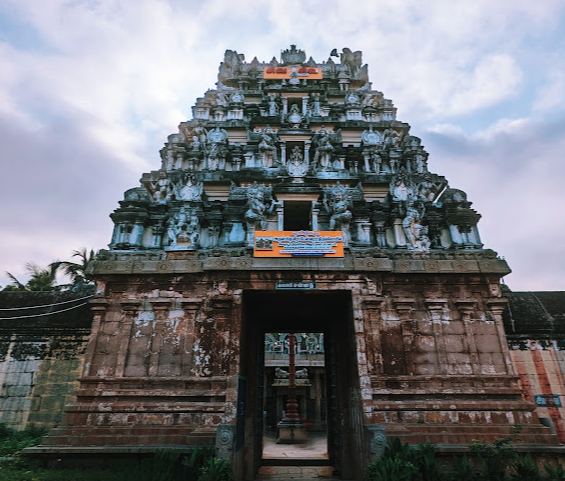Origin/History :-
The original temple was constructed during the 7th century by Nandhivarma Pallavan and later underwent renovations and expansions under the patronage of various rulers. These included Nandhivarman III and Nirupathungavarman of the Pallavas, the Rashtrakuta Kings like Krishnan III, and several Chola Kings, namely Parantaka Chola, Rajaraja Chola I, Rajendra Chola I, and Rajaraja Chola III.
The temple holds a significant connection to Rajaraja Chola I, as it is believed he was born here, with his mother being from this region. His sister, Kundavai, made notable endowments, including the donation of a golden flower, 300 sheep (Saava Moova Peradukal), and 2000 kalanju of gold to ensure the perpetual burning of lamps in the temple.
Inscriptions reveal that this site was historically referred to as Thirukovalur, and the presiding deity, Lord Shiva, was called Thiruveeratanamudaya Nayanar.
These records highlight the temple’s ancient prominence and its role as a spiritual center.
Key inscriptions document various endowments over time. During the 10th year of Vikrama Chola's reign, 2400 kuli of land was donated by
Kiliyur Malayaman Nanootruvan Malaiyan alias Rajendra Chola Sethirayan to the Thivunnalikai Sabha of Devankudi for perpetual lamps. In the 2nd year of Rajaraja Chola I's reign, a total of 7000 kuli of land across various fields was gifted by Mambakkilan of Devankudi for worship and offerings. Additionally, during the 4th year of Rajadhiraja Chola II's reign, a tax-free gift of 1½ veli of land was made by Kiliyur Malayaman Periya Udaiyan Iraiyuran alias Rajaraja Sethiyarayan of Perumpadikaval for 30 Sandhi lamps to be lit up to Arthajama Puja.
The temple's history is a testament to its religious and cultural significance, receiving extensive patronage and endowments over centuries.
Puranic Significance :-
Once, in a playful mood, Mother Parvathi covered Lord Shiva’s eyes, which symbolize the Sun and Moon. This caused the world to plunge into darkness, and from this darkness emerged a demon named Andhaka, representing both darkness and ignorance. To save the world, Lord Shiva struck Andhaka with a club, but every drop of his blood that touched the ground gave rise to another demon. To prevent this, Parvathi collected the blood in a bowl. The blood formed a grid of 64 squares, and Lord Shiva created 64 Bhairavas, each guarding a square, to stop the multiplication of demons. This event later became associated with Vaastu Shanti Puja, symbolizing the destruction of ignorance and the enlightenment of knowledge.
In another version from the Shiva Purana, while Lord Shiva was meditating on Mount Mandara, Parvati’s playful gesture of covering his eyes led to her sweat forming a terrifying, blind boy. Lord Shiva declared the boy their child and named him Andhaka. The boy was later gifted to the demon king Hiranyaksha as his son. Following Hiranyaksha’s death, Andhaka performed severe penance to please Brahma, gaining boons of strength and conditional immortality.
However, blinded by power, Andhaka became a cruel ruler and conquered the three worlds.
While searching for a place to stay, Andhaka’s generals discovered Parvathi in a cave. Mistaking her for an ordinary woman, Andhaka tried to claim her, prompting a battle with Shiva. The fight raged for 500 years, with Andhaka’s blood spawning more demons. Mother Parvathi collected the blood in a pot, which formed the 64-square grid of the Vaastu Mandala. Lord Shiva manifested 64 Bhairavas to defeat the multiplying demons. Eventually, Shiva impaled Andhaka on his trident, and the demon hung there until he realized his mistakes. Andhaka then sought forgiveness, which Lord Shiva granted, making him the leader of his Ganas.
The Veeratta Sthalam : This temple is one of the Atta Veeratta Sthalams (eight sacred sites) where Lord Shiva exhibited his heroic acts of bravery. Of these eight, this site is where Shiva defeated Andhakasura. Unlike other locations, where Shiva pinned demons to the ground, here he lifted Andhaka on his trident until the demon achieved redemption. This place holds historical and mythological significance and is revered for its association with the origins of Vaastu Shastra.
